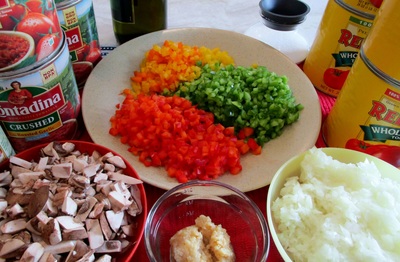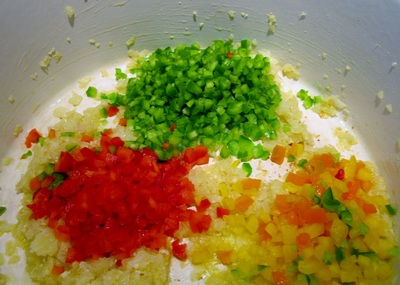So much fun was had in the moment we forgot to take pictures. (I’m actually not sorry about that.) This explains why the photo above is NOT spaghetti [we ate it all] but an alterna-pasta I made the next day to go with the extra sauce.
My ‘feed a crowd’ strategy was similar to last time: simple, hearty comfort food with plenty of options to suit individual taste buds, all served buffet style from the kitchen counter. At Game Night #1 we served soup and chili, salad, and jalapeno-cornbread. This time we chowed down on spaghetti with a meat-free tomato sauce and a choice of turkey meatballs, Italian sausage, or giant broccoli spears on the side. A big green salad with mix-ins and garlic bread rounded out the meal.
I am originally from New Jersey which for a small state has an awful lot of residents, many of them Italian-American. Drive down any thoroughfare with the window open and your nose will be (delightfully) assaulted by aromas of garlic, tomatoes, and oregano bubbling away on somebody’s Nonna’s stove. I say this to indicate that I know from spaghetti sauce aka red sauce aka ragu aka gravy.
I love to make sauce but rarely do it anymore as it’s an all-day endeavor. It’s also an improvisational activity, not especially recipe-friendly. Taste, add a little more of this or that, taste again, and keep tweaking until your hungry soul says “Yes!”
So below you’ll find the skeleton of my recipe for tomato sauce along with suggestions to make it your own. The rest will have to come from you -- and Nonna.
This makes a very large batch. Freeze some or cut down the quantities, as you please.
Click the photos to enlarge them and read the captions.
Note: The quantities shown will make a very large batch of sauce. It freezes well, or if you’re knowledgeable about canning/preserving foods that’s another option. Or just cut down the recipe by about half – you’ll still have a big batch, just slightly more manageable.
Feel free to vary the veggies and herbs. Use more or less garlic, as you wish. This is a highly flexible recipe. Taste frequently as you cook, making adjustments as you go – especially salt and pepper throughout, not just at the end. Remember that a wonderful depth of flavor will develop as the sauce simmers over several hours so just be sure it’s a flavor that you like.
INGREDIENTS:
- 4 tablespoons olive oil, separated (3 tbsps. + 1 tbsp.)
- 2 medium onions, finely chopped
- 3 bell peppers, cut into very small dice – I used one each green, red, and yellow, but use what you like
- 6 cloves garlic, minced
- 8 oz. mushrooms, chopped – I used regular button mushrooms but you can use wild ‘shrooms if preferred, or a mix
- 4 large cans (28 oz. each) whole tomatoes
- 4 large cans (28 oz. each) crushed tomatoes
- 1 small can tomato paste
- 1-2 cups red wine
- Herbs – fresh or dried: Your choice but in my opinion basil and oregano are a must; thyme and rosemary are nice options; and crushed fennel seeds will make the sauce sing!
- Sugar – To taste, between 2 tablespoons and ½ cup, depending on the acidity of the tomatoes and your total quantity of sauce
- Salt and pepper, to taste
DIRECTIONS:
- Heat 3 tablespoons of olive oil in a very large heavy saucepan or two medium/large heavy saucepans over medium-high heat.
- Add the onions, stir, then cook until softened, about 4 minutes.
- Add bell peppers and a pinch of salt. Stir once or twice, cook until softened, about 3 minutes.
- Add garlic, stir and cook for 30 seconds.
- Add mushrooms and remaining 1 tablespoon olive oil. Stir together, reduce heat to low, and partially cover pan. Cook until mushrooms have softened, about 5 minutes.
- If using fennel seeds (optional) or other non-leafy herbs and spices, add them to the pan now. Give a stir and cook for 2 minutes.
- Add canned crushed tomatoes to the pan and give it a stir to mix everything together. Increase heat to medium-high.
- Add canned tomatoes to the pan, including the liquid. Break the whole tomatoes apart with your fingers. (I use gloves but well-washed bare hands are okay too.)
- Add 1 teaspoon salt and several grinds of pepper. Add 1 teaspoon of sugar. Stir to mix.
- Bring sauce to a near-boil, then reduce heat to low, cover and simmer.
- Check the sauce every 30 minutes or so – taste for flavor and adjust accordingly. My routine usually goes like this:
- 1st check-in: Probably a little more sugar (to combat the acidity from the tomatoes), salt and pepper.
- 2nd check-in: Add leafy herbs such as basil and oregano. Probably add a cup or so of wine. It doesn’t need to be your best wine, but it should definitely be good enough to drink.
- 3rd check-in: Turn off the heat, keep the sauce covered and let it rest for a little while, 30-60 minutes or so.
- 4th check-in: Turn the heat back on low, give everything a stir and a taste. What does it need? Probably more sugar, salt and pepper. (Don’t worry – it’s still less than you’ll find in a jar of sauce at the grocery.) More wine? A dollop of tomato paste to thicken it up and intensify the tomato flavor? You’re the boss.
- 5th check-in: You’re probably extremely close to done by now. Have a taste and adjust as needed. My secret weapon (if I’m not worried about keeping the dish vegetarian) is a few dashes of Worcestershire sauce or a squirt of anchovy paste. That’ll really bring the umami! If you’ve added anything, let the sauce cook for at least 15 minutes more, then turn off the heat, keep the pan covered, and let the sauce rest again for at least 15 minutes. I think this helps to “settle” the flavors and let them meld together.
Photos: Ann Johnson













 RSS Feed
RSS Feed